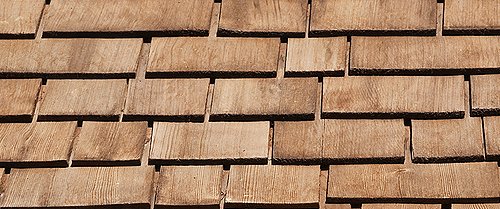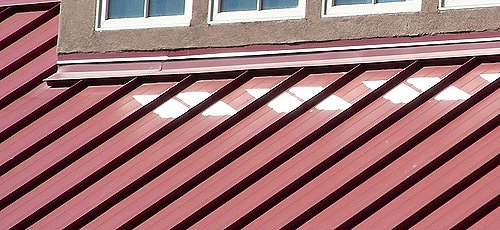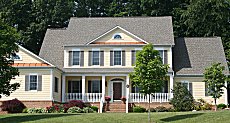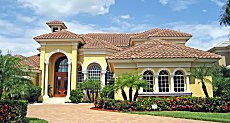Choosing The Right Roofing Materials
Choosing the right roofing materials for your home might not be the most exciting way to spend your time but sooner or later you'll need a new roof. That's why it's important to understand what you're getting into (or under) so you can maximize the return on your investment.
What you basically need to know is that there are a range of roofing choices available to you, each with their own attributes. The important point here is that these options allow you to tailor your choice based on what factor is most important to you, be it budget, longevity, style or a combination of all three.
Typically, lower-cost roofing comes with a shorter lifespan while more expensive roofing has greater longevity. The trick is finding the right balance between those characteristics.
You should also be aware of the fact that the roof covering (the shingles or sheet metal) is part of a larger roofing system. That system includes other important items like sheathing, underlayment, flashing and similar provisions necessary for a leak-proof roof. Proper insulation and ventilation also play an important role in the roofing system.
A good roof protects everything underneath it. Paying close attention to what's available and how they perform will serve you well in getting a roof that's durable, long lasting and economical too.
Roofing Materials And Their Pros & Cons
Knowing what's available is your first step toward making the right roofing choice. There are tried-and-true roofing materials made from a variety of materials, some which have been around for centuries. Others aren't so old and take advantage of newer technologies that offer traditional looks while aiming for lower cost and/or better performance.
To get familiar with the kinds of roofing choices that are available here's a list of the most common types along with their highs and lows.
Asphalt Composition Shingles
 |
Asphalt shingles, also known as "composition shingles" are one of the most prevalent types of roofing materials available. They're a combination of a backing (either fiberglass or an organic material like cellulose), asphalt and mineral granules. Asphalt shingles are easy to work with and install which makes them one of the better do-it-yourself roofing options. Most asphalt roofing products are economically priced although some of the top-line premium products can rival the cost of more expensive roof types. You can learn more about this kind of roofing on this page.
| Pros | Cons |
|
Relatively inexpensive / most economical of roofing options Class A fire rating for fiberglass-backed asphalt shingles (organic-based shingles have Class C rating - lower than Class A) Premium grades have a longer life span than budget "3-tab" asphalt shingles Plenty of product choices for various styles, color selections and budgets Relatively easy to install - doesn't necessarily require a craftsman with years of experience in the trade (like slate) Premium shingles have a longer warranty than basic shingles Some U.S. states have asphalt shingle recycling programs |
The premium architectural styles are more expensive than basic 3-tab shingles Asphalt shingles degrade over time due to exposure to sun and the environment (it's not a 'forever' type of roof) The more basic shingles are more prone to impact (hail) damage than harder roofing and more premium (thicker) asphalt shingles Minimal to moderate color selection (vs. metal or tile with a wider range of color) |
Wood Shingles
 |
Wood roofing shingles have been around a long time and continue to be a good roofing choice. They're typically made from cypress, redwood, pine and western red cedar. They're a good choice for more steeply-pitched roofs that can show off the nicely textured visually aesthetic that they naturally offer. One of the biggest considerations regarding a wood roof is its susceptibility to fire and whether your building code will allow the use of a wood roof. Wood roofs can be treated to be fire retardant but they won't be fireproof and over time the fire-resistant properties may degrade.
| Pros | Cons |
|
Visually appealing roof style with nice visual texture particularly on steeper roof slopes where more of the roof is visible Wood roofing is a greener choice - made from sustainable materials and biodegradable once used up Generally cooler than other types of roofs that are generally darker in color (like many asphalt selections) |
Best installed by professionals with experience installing wood roofing Not fireproof and not a good roof choice in fire-prone areas (areas with seasonal risk of wildfire and similar fire risks) Subject to rot and decay over time unless treated periodically with preservative and fungicide and/or kept clean and free of debris Weathers to a dull gray appearance Requires more maintenance than other roof types such as keeping clean/clear of pine needles and other natural debris that can retain moisture, promoting decay |
Metal Roofing Shingles / Sheeting
 |
Metal roofing is available in several materials including steel, aluminum and copper. It also comes in several forms: sheeting (which includes the predominant type known as "standing seam" roofing) and tiles. If you don't like the smooth look you can buy stone coated steel roofing which has the texture of asphalt roofing.
Standing seam metal roofs are made from panels with a small vertical flange at the joint where the panels meet similar to what's shown in the photo above. Metal roof tiles are installed in a similar fashion to other roofing tiles and shingles. Metal makes for a durable roof but requires careful consideration from a style perspective, particularly the standing seam variety. You'll need to consider how it will look relative to your home's design and the architectural style of the homes in your neighborhood.
| Pros | Cons |
|
Offers long lasting durability Good at shedding snow and ice Fireproof Some metal roofing products are made from recycled material and can be recycled when it they need to be replaced Metal roofing has some of the better cool energy efficient roofing characteristics |
The look, particularly standing seam (long panels) may not be consisistent with your home and/or neighborhood architectural style Needs good corrosion protection (both steel and aluminum) Steel (unprotected) will rust and even painted steel is not a good choice in corrosive environments such as coastal locations Metal roofs, particularly flat standing seam panels, spill water at a faster rate than more textured roofs - rain gutters need to be sized accordingly to handle the runoff Denting is a risk with falling tree limbs, large hail and similar debris |
Clay or Concrete Roofing Tile
Tile roofs not made from metal or a composite material are typically clay-based or made from concrete. Tile roofs are another durable and long-lasting roof but they are heavy and your underlying roof structure needs to be designed to take the load. Clay or concrete tiles are available in a variety of styles. Some products are even made to mimic other types of roofing like wood shake. In those cases, you get the textured wood-look with a durable and fireproof roof covering. Tile roofs can be expensive however with clay-based tiles usually costing more than concrete tiles.
| Pros | Cons |
|
Durable, long lasting and relatively maintenance-free Fireproof Offers a range of architectural styles Can be used to mimic other types of shingles like wood or slate Good energy efficiency possible with tiles that have higher reflectance (reflecting the sun's energy) Good insulating value due to the air gap between the tiles and the roof decking More color options are available |
Requires professional installation by experienced installers More expensive than typical asphalt or wood roof installations (clay is typically more expensive than concrete) Tile is heavy - roof decking and structure need to be engineered to support it) Tile roofs are more fragile than other types of roofing and care must be taken when stepping on a tiled roof |
Slate Roofing
 |
Slate is real stone and is one of the most durable and long-lasting types of roofing material you can choose. Slate roofs can be beautiful and there are several shades of slate you can choose from. A slate roof is also heavy however and your roof framing needs to be engineered to support this style of roofing. Along with the beauty and durability however comes a fairly high price tag -- slate is one of the most expensive roofs you can choose.
| Pros | Cons |
|
Arguably one of the longest-lasting roofs you'll find - can last indefinitely Adds a nice visual appeal on the right style of home Fireproof Slate roofing can actually be reused unlike other forms of roofing |
Requires professional installation with contractors that have experience with this type of roofing Underlying roof structure may need reinforcement / must be built to withstand the heavier weight of slate which adds to the home's framing costs One of the most expensive types of roofs available |
Composite Roofing (Rubber / Plastic / Fiber Cement)
 |
| Photo Courtesy Of CertainTeed |
| Pros | Cons |
|
Offers a lower cost alternative to more expensive roofing styles (slate) and/or more maintenance-intensive materials like wood Lighter than conventional slate or concrete tiles and can be installed over standard roof structures Some products are made from recycled materials like old car tires Has the potential for a very long-lasting roof (based on assumptions made about the material properties of these products) |
Visual quality varies and is subjective - some products look more convincing (of other roofing products like slate) while others may have a more plastic look to them Relatively new on the market so long term performance (durability, color retention) is not fully known |
What You Should Consider When Choosing Roofing Materials
Choosing the right kind of roofing material requires you to take a number of factors into consideration. There's the aesthetic piece of course but you can't forget about the more mundane but still important aspects like your home's environment, how long you plan on staying in your home and other important factors.
Your starting point for making any decision begins with whether you're choosing an original roof (for a new home) or replacing a roof on an existing home. A similar situation to the latter is matching an existing roof on an addition.
If you're starting from scratch with a new roof on a newly-constructed home you have the luxury of considering all the choices that are available.
Choosing a roofing material to replace an existing roof involves different considerations, one of which is whether to stay with the old style of roofing.
So before you get your heart set on any particular type of roofing, consider these points to help you become a more educated buyer and hone in on the right roofing choice.
- New Roofs vs Replacement Roofs
New roofs offer fewer constraints from a choice perspective than replacement roofs. Replacement roofs have to contend with pre-existing conditions like roof pitch, the type of existing roofing and the makeup of the underlying roof structure.That doesn't mean you can't change the type of roofing on a pre-existing roof. However you'll need to determine whether the new roof will "work" and be functionally compatible with your home. A good roofing professional can help you make that decision should you want to re-roof with a different roofing material.
- Does Your Code Require A Particular Roof Type/Material?
Certain cities may require a particular type of roofing material and/or or grade of material. Contact your local municipality's building department to see if any such restrictions apply before choosing. - How Long Do You Plan On Staying? (Cost Vs. ROI)
A good roof will cost you several thousand dollars or multiple times that amount depending on your home's size and the roofing choice you make. The more expensive roofing materials may not make sense if you don't plan on staying in the home much longer.If you need a new roof now but plan on moving soon after, make more economical choices for your own benefit rather than putting on an expensive roof for the next owner.
- Be Aware Of Building Codes & Covenants
Before you choose a roofing material you should find out if there are any restrictions against using a particular type of roof shingle. For example, there are restrictions in parts of California against using wood roof shingles. In communities with building covenants there are sometimes restrictions against using asphalt shingles in order to maintain a certain look with the homes in the community. - Roof Pitch & Shingle Choice Affect Both Curb Appeal & Durability
Steeper-pitched roofs are visually more prominent and present a broader "face" than flatter roofs, making a greater impact on your home's aesthetics. Choosing roofing materials that are visually attractive and interesting and complement the rest of the home increases its curb appeal. - Think About Using Energy Efficient Roofing Materials
Energy efficient roofing, also known as "cool roofing", offers both financial and environmental benefits. It essentially helps reduce cooling needs by helping deflect the sun's energy, keeping your house cooler. It's particularly important/effective in warm, southern climates where cooling needs are prevalent during the year. You can read more about cool roofing here. - Consider Waterproof Underlayments
Roofing felt, a form of tar paper, has traditionally been used as an underlayment beneath roof shingles and is considered to be water resistant as opposed to waterproof. As an upgrade you may want to use a self-adhesive waterproof underlayment (modified bitumen membrane). It will cost more than standard roofing felt but it can provide an impervious shield of protection in addition to the roof covering. At a minimum, it is excellent insurance when used on the eaves (roof edge) in locations that are prone to ice dams in the winter. - Consider Large Trees Close/Over Your Roof
Some roof types do better than others when there are trees that are taller than the home and close to the roof (or actually hang over the roof). Although any shingle can be broken if a branch that's large enough falls on it there are roofs that are cheaper and easier to fix than others. In this scenario, a sturdy (thick) asphalt shingle might be a better choice than a clay-based tile roof. If you choose an expensive roof and you need repairs due to tree damage you also risk a negative impact on your insurance rates.
If your home has large trees over the roof you'd be better off trimming or removing the trees or choosing a more economical but sturdy and easy-to-repair roofing material like asphalt shingles.
- Color Variations Add Visual Texture
Asphalt shingles that use several different shades of color add some visual texture to a roof. Roofs with no color variation, particularly 3-tab asphalt roofs, can look very flat and monochromatic. - Architectural Style Plays A Role In Roofing Choices
Consider the style of your home when choosing a roof material. The majority of homes will do fine with composition asphalt shingles but certain styles of homes, or historic homes, might be better off with a different style of roofing such as tiles or slate. Faux roofing materials come in handy in these situations because they can mimic a slate or wood shake roof for a potentially lower cost and less maintenance.


On the other hand metal roofs naturally shed water and snow more readily than other roof types so using metal on a steeply pitched roof may require gutters that are sized appropriately to handle the runoff.
Steeper roofs are also more visible, making up a larger portion of what you see every time you drive up to your house. Choosing an aesthetically pleasing and complementary roofing shingle will certainly help bolster your home's curb appeal.
Important Points To Know About Roofing Material Warranties
Roofing manufacturers often tout the robustness of their warranty and you'll see references to 30, 50 and even lifetime warranty durations. To some degree there's some marketing going on since most of us naturally hear "lifetime warranty" and think that the stuff must be pretty good.
Well, with warranties like that, the material usually is pretty good. But don't be too swayed by what sounds like a rock-solid warranty term before understanding what's really covered, what isn't, and the conditions that apply.
Here are the main points about roofing warranties to be aware of:
- Warranties Cover Defects - Not Roof Life Duration
Roofing material warranties only cover problems caused by defects due to manufacturing deficiencies, not general deterioration or failure of the roof to last for 30 years. The life of your roof is dependent on environmental factors, how well it was installed and other conditions like your home's insulation and ventilation. In other words, a 30-year roof warranty doesn't mean your roof will actually last for 30 years. It just means the actual product (the shingles or roof covering) will be free from problems caused by a manufacturing flaw. - Warranties Cover Only A Few Specific Conditions
A roofing product warranty typically only covers several specific performance conditions such as wind (blow-off) resistance, algae resistance (for asphalt shingles) and manufacturing defects as mentioned above. - Coverage Is Usually Pro-Rated
Roofing warranties are usually pro-rated after a certain "up-front" time duration, after which any compensation is reduced based on the number of years past that initial term. - Understand The Details (Coverage & Compensation)
Take the time to actually read the manufacturer's warranty before you buy to understand the details and specifics about the coverage. For example, algae coverage on an asphalt roof means compensation is in the form of cleaning, not a new roof or replacement shingles. Other details include specific wind speed ratings above which your roof won't be covered. - Be Aware Of Language That Make Claims Hard To Prove
This might be better titled as 'diminish your expectations'. Warranties contain language that can possibly make proving your case a he-said/she-said affair. For example, some warranties cover algae staining that is only "significant" -- the question is, how do you determine what defines 'significant' and who makes the call?When it comes to wind damage, warranties first specify that the shingles must have been installed in accordance with the manufacturer's instructions and not during a cool season (in the case of asphalt). Proving that these conditions were met might not be that easy although keeping your receipt that shows the time of year your roof was installed helps. If you installed your roof during the cool season you may not be eligible for this coverage.
Also, you'll need to conclusively determine that shingles were damaged by winds that did NOT exceed warranty limits. To do this some warranties require National Weather Service records or similar to validate maximum wind speeds when the damage occurred for your county or local area.
- Short Notification Periods
Warranties often include a notification period within which you'll need to make the manufacturer aware of any damage that you notice. In some cases this can be 30 days and you'll need to provide documentation of the damage. - Find Out What's NOT Covered
Be aware of what's not covered. This usually includes things like faulty installation, inadequate ventilation or drainage and faulty building design among others. Understanding what isn't covered is just as enlightening and important as knowing the terms associated with what is covered. - Don't Forget The Installation Warranty
The roofing material manufacturer's warranty is only half the picture. The other half has to do with the installation of the product. Find out what kind of installation warranty your roofing installer provides and understand the details keeping in mind the same items noted above such as what's covered, what's not and what compensation is provided. - Keep Your Documents
To go along with #8 (installer's warranty), make sure you keep documentation on the installer and their warranty. It doesn't take long before the person/company that's done the work is forgotten and out-of-mind. If you do have a problem down the road, you'll want to know who you can contact and be able to show them documentation that they did the work along with their warranty.
As you can see, the fine print of roofing material warranties deserves close examination so that you don't go into a purchase with unrealistic expectations.
This isn't to imply that roofing material manufacturers are trying to dupe anyone with their warranty claims. It's simply that they can be used as a marketing tool to some degree and it pays to really understand what they truly cover and how you are compensated for any problems. Don't buy a roof based simply on the fact that it has a 50 year or lifetime warranty. Do your due diligence and read the warranty first.
Free Estimates & Finding Local Roofing Sources
If you'd like to find roofing suppliers and installers in your local area, fill out the form below. HomeStyleChoices.com partners with Reliable Remodeler to help homeowners find local contractors and sources of products.
When you use this form you'll be contacted at your convenience by several roofing professionals who can provide free estimates for your project. Just click the appropriate radio buttons on the form and then input your zip code. There's no obligation and it's a convenient way to make contact with local sources that may be able to assist you.
Here's More Related Info That Might Be Helpful...
Asphalt Roofing - It's one of the most predominant roofing materials there is and for good reason. Find out what you should know about this tried-and-true roof.
Cool Roofing - Your roof can actually be energy efficient. Find out why and how this kind of roof can benefit your utility bill.
Artificial Slate Roofing - Real slate roofing is heavy and expensive and takes skilled labor to install. Discover the alternative to real slate in this article on faux slate roofing.
